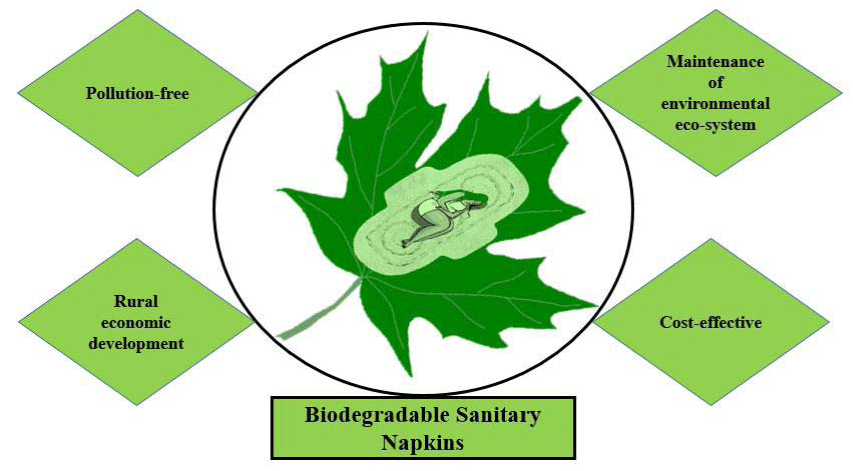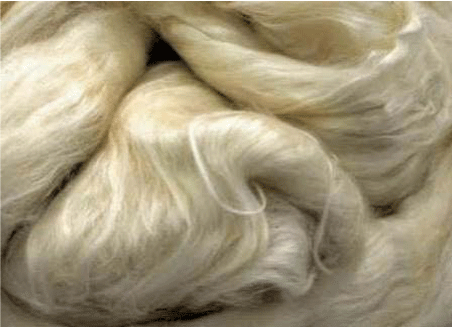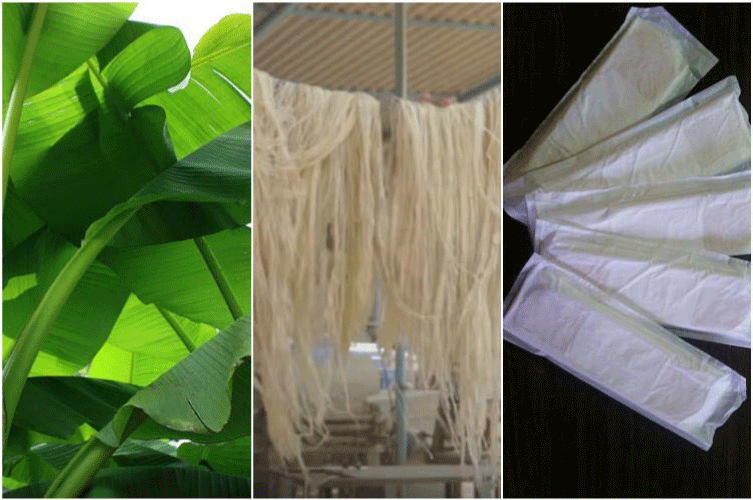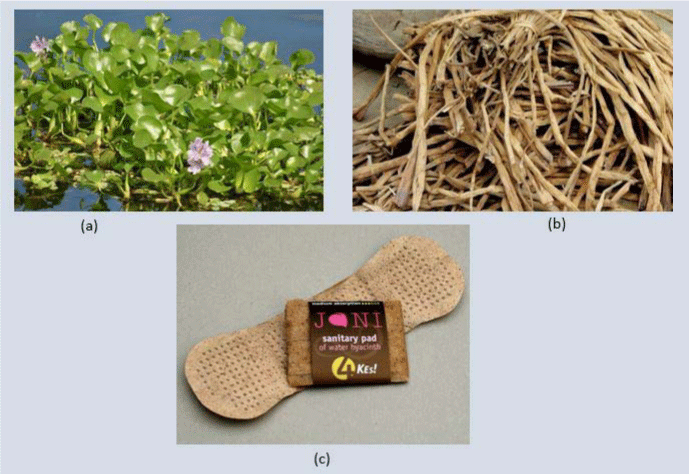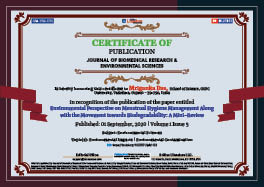> Environmental. 2020 September 01;1(5):122-126. doi: 10.37871/jels1129.
-
Subject area(s):
- Environmental Impacts
- Environmental Contamination
Environmental Perspective on Menstrual Hygiene Management Along with the Movement towards Biodegradability: A Mini-Review
Isita Ghosh1, Dhaivat Rakholia2, Keyur Shah2, Disha Bhatt3 and Mriganka Das3*
2School of Technology, GSFC University, Vadodara, Gujarat - 391750, India
3School of Science, GSFC University, Vadodara, Gujarat - 391750, India
- Sanitary napkins
- Biodegradable
- Natural fiber
- Bamboo-banana-jute- hemp fiber
- Commercial
- Environmental impact
The topic indicated in this mini-review is an essential factor for the improvement of society through a clean environment movement. Now, this era of microbes forces us to make such kind of development for creating hazard free and healthy life. Girls in rural areas use old cloths, tissue paper, cotton, wool pieces, or a combination of these items to manage menstrual bleeding. Qualitative studies indicate that only those girls who know about several conventional sanitary pads, they prefer to use it. But for many girls, such pads are unavailable or unaffordable. These pads, when flushed, swell up due to saturation with liquid results in sewage blockage, which is a global problem. Sanitary products with the blood of an infected woman/girl may contain hepatitis and HIV viruses where pathogens can live up to 6 months and will retain in soil/water bodies. Incineration is a technique to dispose of menstrual waste. But the burning of pads releases gases that affect health and environment, where the chemical dioxins are toxic and carcinogenic. Considering this drawback, biodegradable sanitary napkins made from natural fibers are a perfect alternative route creating a hazard-free environment. This article focus on the development of different biodegradable sanitary napkins that are made up of the fiber of different plasnts like jute, banana, cotton, water hyacinth bamboo etc. This development provides infection and irritation-free menstruation using bio-active materials of plant origin, which also possess anti-microbial properties. The final implementation of this product will also benefit society by employing rural women empowerment.
According to WHO, the 10-19 years of age group persons are called adolescents [1]. In this period, a person goes through the physical and mental change [1]. Between these periods, menstruation is started in the life cycle of a girl. The starting of the menstrual cycle is called menarche. The average age of menarche is 12-13 years of age [2,3]. Menstrual wastes are waste that is produced by a female in her reproductive phases. These wastes are created during the menstrual cycle, generally known as periods, menses, or monthly bleeding cycles.
Menstrual liquid might possibly have a terrible scent, mainly when it interacts with the air. Ladies have built up their very own systems to deal with this timeframe. Internationally, these methodologies shift significantly because of the individual inclinations, accessibility of resources, financial status, social conventions and convictions, education status, and information about the menstrual cycle. Practices identified with menstrual hygiene are of significant concern as it has a health sway; whenever dismissed, it prompts harmful stun disorder, Reproductive Tract Infections (RTI), and other vaginal problems. Poor vaginal health adversely influences young ladies' health. Most young ladies are uninformed and caught off guard for menarche as they are not educated or poorly educated about period [4] (Figure 1).
Different kind of restrictions and cultural belief related to the menstruation
Menstruation is a natural biological process of every female after reaching the adolescence period. In India, the menstrual cycle is a taboo, and it is considered as a dirty or unclean thing. In some regions of India, at the time of the menstrual cycle of a girl, she will not allow to join any temple and also not allow to cook stop, or end of menstruation indicates the stop of reproductive phase or a female known as menopause. Generally, menopause occurs in between 46-51 years of age group (46.2 for Indian and 51 for Western counterparts) of females [5].
Types of Absorbents Used at the time of menstruation
The choice of sanitary napkin material depends on the person's selection, social adequacy, financial status, and availability in the local market. Alongside a general sanitation facility, one ought to be additionally given a soap and menstrual pad to manage menstrual cycle hygiene. The selection of absorbent materials varies among country and urban ladies and young ladies. In rural regions, the most favored absorbents are reusable material cloth, and in urban zones, ladies like to utilize commercial sanitary napkin. Chlorine-blanched Kraft or sulfate mash is being used by makers to deliver fluff pad as absorbent used to make expendable sterile items. These days, many perfumed clean things are accessible in the market made of artificial fiber rayon. These freshened up items contain synthetics like organochlorines, which have antibacterial action. Because of their substance synthesis, these items, when covered in the soil, they kill the soil microflora and delay the procedure of decay [6]. Unique menstrual items utilized by ladies/young ladies are discussed below [4].
Around 48% of Indian ladies, despite everything, use material during their periods. Clean napkins now being accepted in the rural regions also. Items like tampons, wholesale napkins, and menstrual cups are simply being presented. The sterile towel is, at present, the most broadly utilized item in India. Attributable to the sizeable untouchable spread in the nation identified with the monthly cycle, ladies are as yet hesitant to utilize legitimate sterile clean items. Since quite a while ago, overlooked conventions are as yet being followed in certain towns, which causes issues identified with health among ladies utilizing debris, soil, dried leaves during periods to drench, the blood is even continued today. Significantly, ladies be made mindful of the significance of utilizing sterile sterilization items to dodge diseases and other health issues [7].
Impact on the environment of no biodegradable sanitary pad
In a country like India which comprises of more than 655 million ladies, 48% of them don't know about the correct use of a sanitary napkin. Removal of the used sanitary pad is a significant challenge across India. The absence of awareness and some taboo related to the period in India means the issues of legitimate hygienic waste management. This irresistible waste, if not dealt with appropriately, would create vast pollution to the seas, land, and human health. Up until now, while significance was offered uniquely to advancing the utilization of sterile napkins, it is similarly significant that the issues brought about by dumping clean waste in landfills be tended to. Considering the different dangers brought about by this broadly acknowledged at this point dangerous removal strategy, it is essential to think of an answer that is sustainable on each front. To avoid the extension of the issue, a decentralized answer to handle the menstrual waste at its age point is indispensable [7]. With this article, we are discussing some biodegradable sanitary napkin, which is used now a day.
In spite of the underuse of appropriate sanitary items in India, menstrual waste is expanding every day in the ever-increasing population. A normal lady discards around 150 kg of non-biodegradable waste each year. With changing socioeconomics and inclinations, the measure of non-biodegradable sterile napkins utilized in India is developing. As ladies are getting more mindful about the significance of using clean, sterile items, the quantity of clean napkins utilized every month is going to increase quickly. Diverse eco-accommodating items like biodegradable napkins and menstrual cups have as of late began picking up significance. It will be a very long time before the use of non-biodegradable clean napkins scales down. This is expected that 121 million ladies and young girls are as of now utilizing a normal of 8 dispensable napkins on every month, the waste burden created in India is evaluated to be: - 1.021 million pads accumulated month to month 12.3 billion and yearly 113,000 tons of menstrual waste produced every year [7].
Some biodegradable sanitary pads
Bamboo fiber pads: Rather than wood fiber, bamboo fiber is used as an absorbent material as a menstrual pad. Bamboo fiber has some unique properties that can be converted easily into a fabric [8]. Regenerated bamboo fiber has a hundred percent cellulose, and it is biodegradable and completely eco-friendly [9]. It has a more absorbent limit and is more secure to use. The pads made up of bamboo have antibacterial properties and are very soft [10]. The absorbance capacity of bamboo fiber is more than cotton fiber [11]. This gives contamination and irritation-free menstrual cycle. Additionally, bamboo fiber pads are accessible in the market with the advantage that blood stains are not plainly noticeable and are reusable in nature [4].
The chemical composition of bamboo fiber is given below table 1, the texture of bamboo fiber is depicted below by the following figure 2.
Table 1: The chemical composition of bamboo fiber is given below. |
|||||
| Species | Lignin (%) | Cellulose (%) | Pentosan (%) | Ash (%) | Ethanol Toluene Extractives (%) |
| Phyllostachys neterocycla | 26.1 | 49.1 | 27.1 | 1.3 | 4.6 |
| Phyllostachys nigra | 23.8 | 42.3 | 24.1 | 2.0 | 3.4 |
| Phyllostachys reticulata | 25.3 | 25.3 | 26.5 | 1.9 | 3.4 |
Banana fiber pad: These days, cheap and clean pads for rural ladies produced from the banana tree fiber were sold under trademark "Saathi" in India. They are ecofriendly and decompose within a year after use [4]. Banana Fibres are generated as surplus material of banana cultivation. Consequently, with no extra cost, these fibers can be acquired for the modern sanitary pad industry. The banana plant gives heavenly natural products as well as provides material fiber. It develops effectively as it sets out young shoots, and it most regularly found in hot tropical atmospheres [12]. All assortments of banana plants have filaments in the bounty. These fibers are acquired after the organic product is collected and fall in the gathering of bast fibers. This plant has, for some time, been a decent hotspot for excellent materials in numerous pieces of the world, particularly in Japan, Africa and Nepal [13]. Banana fiber is a natural sorbent [14]. The texture from this fiber lets you comfort and will keep you cool on hot days. The banana texture is exceptionally delicate and graceful, however not exactly as delicate as cotton or rayon [15]. Nearly all plant stem-based fibers are a little stiff and coarse than cotton. This banana texture is entirely comfortable and liable to trigger allergies. More ever, It is biodegradable. It has excellent resistance power. It is greaseproof, water, fire, and heat resistant [16]. In terms of spin ability and tensile strength, it is perfect even in comparison with bamboo fiber. The main chemical component of banana fiber is cellulose, hemicellulose, and lignin. Its abruption and desorption capability is very good. The chemical composition of banana fiber is given below [17] (Table 2).
Nowadays, several manufacturers are preparing commercial biodegradable sanitary pads using banana fiber. Here a grassroots process in this development is depicted in figure 3.
Table 2: A typical example of the image of a sanitary pad made from jute fiber is depicted below. |
||||
| Fiber Type | Cellulose (%) | Hemi-Cellulose (%) | Lignin (%) | Pectin (%) |
| Banana | 62-65 | 6-19 | 5-10 | 3-5 |
| Fiber Type | Cellulose (%) | Hemi-Cellulose (%) | Lignin (%) | Pectin (%) |
| Jute | 51-84 | 12-20 | 5-13 | 0.2 |
Water hyacinth pad: Water hyacinth is a kind of weed. The stem of the water hyacinth is extracted to obtain fiber [18]. Menstrual pads manufactured using the water hyacinth fiber is sold under the trade name "Jani." They are also eco-friendly in nature, cost-effective, and easily biodegradable. Image of similar kind of commercial sanitary pad in figure 4.
Hemp sanitary pad: "Himalayan Hemp Sanitary pad" is there trade name of a sanitary pad that is washable and reusable. This is made up of a Hemp plant fiber [19].
Cotton and jute fiber pad: Pad manufactured by the combination of jute and cotton fiber is also available now. In India, "Magnas" is the trademark of such a kind of pad. Cotton and jute both have the excellent absorbent capacity and completely biodegradable [20,21]. The chemical composition of jute fiber is given in figure 5.
Menstrual hygiene management is an essential course of study at present, specifically in the rural area of a developing country. Menstrual waste is a critical biohazard. Due to the active awareness now, women are using conventional and commercial sanitary pads, but at the same time, it increases the biohazards in our environment. So there is an obvious need for a good route of safe disposal of used sanitary napkins. Biodegradable sanitary napkins are the best solution for this. In this article, several kinds of biodegradable material used for sanitary napkins are mentioned. Although already a few commercial products on this biodegradable sanitary napkins are available in the market, still there was a lack of awareness. The use of biodegradable sanitary napkins will not only make this environment clean, but also it will bring a ray of hope in terms of the economic development in farmers' life. Farmers will also get encouragement to cultivate this type of plant for the development of new ventures. A perfect approach to the production of these biodegradable sanitary napkins will make the product cost-effective too. Finally, proper awareness of these biodegradable sanitary napkins will bring a new comfort in the life of rural women.
- Thakre SB, Thakre SS, Reddy M, Rathi M, Pathak KUS. Menstrual Hygiene: Knowledge and practice among adolescent school girls of saoner, Nagpur District. J Clin Diagonostic Res. 2011; 5: 1027-1033. https://tinyurl.com/y6rlvj7y
- Diaz A, Laufer MR, Breech LL. Menstruation in girls and adolescents: Using the menstrual cycle as a vital sign. Pediatrics. 2006; 118: 2245-2250. https://tinyurl.com/y2qc45m9
- Bagga A, Kulkarni S. Age at menarche and secular trend in Maharashtrian (Indian) girls. Acta Biol. Szeged. Acta Biol Szeged. 2000; 44: 53-57. https://tinyurl.com/y5e3mgnt
- Kaur R, Kaur K, Kaur R. Menstrual Hygiene, Management, and Waste Disposal: Practices and challenges faced by girls/women of developing countries. J Environ Public Health. 2018. DOI: 10.1155/2018/1730964
- Ahuja M. Age of menopause and determinants of menopause age: A PAN India survey by IMS. J Midlife Health. 2016; 7: 126. DOI: 10.4103/0976-7800.191012
- Tjon A Ten. Menstrual hygiene : A neglected condition for the achievement of several Millennium Development Goals : IRC. Eur Extern Policy Advis. 2007: 22. https://tinyurl.com/yy2cufz2
- Bhor G, Ponkshe S. A Decentralized and Sustainable Solution to the Problems of Dumping Menstrual Waste into Landfills and Related Health Hazards in India. Eur. J Sustain Dev. 2018; 7: 334-344. DOI: https://doi.org/10.14207/ejsd.2018.v7n3p334
- Liu Y, Hu H. X-ray diffraction study of bamboo fibers treated with NaOH. Fibers Polym. 2008; 9: 735-739. https://tinyurl.com/y6r7rdn9
- Erdumlu NOB. Investigation of regenerated bamboo fibre and yarn characteristics. Fibres Text. East Eur 2016; 4: 43-41.
- Wang G, Chen F. Development of bamboo fiber-based composites. Adv. High Strength Nat. Fibre Compos. Constr. Elsevier Inc. 2017: 235-255. DOI: https://doi.org/10.5897/SRE2018.6580
- Sekerden F. A study on comparison of air permeability properties of bamboo / cotton and cotton towels. Sci Res Essays. 2018; 13: 143-147. https://tinyurl.com/y49jvd22
- Bouwman AF. Nitrogen oxides and tropical agriculture. Nature. 1998; 392: 866-867. https://tinyurl.com/y49jvd22
- Abera-Kalibata AM, Gold CS, Van Driesche RG, Ragama PE. Composition, distribution, and relative abundance of ants in banana farming systems in Uganda. Biol Control. 2007; 40: 168-178. DOI: https://doi.org/10.1016/j.biocontrol.2006.11.006
- Deepa B, Abraham E, Cherian BM, Bismarck A, Blaker JJ, Pothan LA, et al. Structure, morphology and thermal characteristics of banana nano fibers obtained by steam explosion. Bioresour Technol. 2011; 102: 1988-1997. DOI: https://doi.org/10.1016/j.biortech.2010.09.030
- Alavudeen A, Rajini N, Karthikeyan S, Thiruchitrambalam M, Venkateshwaren N. Mechanical properties of banana/kenaf fiber-reinforced hybrid polyester composites: Effect of woven fabric and random orientation. Mater Des. 2015; 66: 246-257. DOI: https://doi.org/10.1016/j.matdes.2014.10.067
- Venkateshwaran N, Elayaperumal A. Banana fiber reinforced polymer composites - A Review. J Reinf Plast Compos. 2010; 29: 2387-2396.
- Boopalan M, Niranjanaa M, Umapathy MJ. Study on the mechanical properties and thermal properties of jute and banana fiber reinforced epoxy hybrid composites. Compos. Part B Eng. 2013; 51: 54-57. DOI: https://doi.org/10.1016/j.compositesb.2013.02.033
- Chonsakorn S, Srivorradatpaisan S, Mongkholrattanasit R. Effects of different extraction methods on some properties of water hyacinth fiber. J Nat Fibers. 2019; 16: 1015-1025. DOI: https://doi.org/10.1080/15440478.2018.1448316
- Shahzad A. Hemp fiber and its composites - a review. J Compos Mater. 2012; 46: 973-986. DOI: https://doi.org/10.1177/0021998311413623
- Rana AK, Mandal A, Mitra BC, Jacobson R, Rowell R, Banerjee AN. Short jute fiber-reinforced polypropylene composites: Effect of compatibilizer. J Appl Polym Sci. 1998; 69: 329-338. DOI: https://doi.org/10.1002/(SICI)1097-4628(19980711)69:2<329::AID-APP14>3.0.CO;2-R
- Gibeop N, Lee DW, Prasad CV, Toru F, Kim BS, Song J Il. Effect of plasma treatment on mechanical properties of jute fiber/poly (lactic acid) biodegradable composites. Adv Compos Mater. 2013; 22: 389-399. DOI: https://doi.org/10.1080/09243046.2013.843814
Content Alerts
SignUp to our
Content alerts.
 This work is licensed under a Creative Commons Attribution 4.0 International License.
This work is licensed under a Creative Commons Attribution 4.0 International License.
